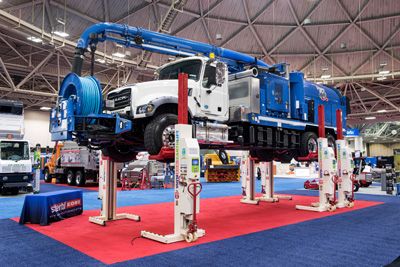
Mistakes to Avoid When Selecting Maintenance Bay Lifts
As Dale Collins, CAFM, has rightsized his fleet in recent years, the fleet services supervisor for Virginia-based Fairfax Water has discovered the need to rightsize his maintenance bay lifts as well.
When the vehicle maintenance facility was built, the fleet had a higher percentage of heavy-duty dump trucks and crew vans, so the emphasis was on lifts that could handle their 60,000-pound weight. These days, however, Collins can service 80 percent of his fleet with more efficient 12,000-pound-capacity cassette lifts.
“Anybody who is in the market for a lift has to know what it is they’re trying to lift, how much it weighs and what the lift’s wheelbase limits are – not only how small it will get, but how long you will need it to be,” Collins said. “A lot of times you can get into a jam with longer vehicles.”
Collins speaks from experience; one Freightliner in the utility’s fleet has a 328-inch wheelbase. But the fleet department was able to work with the lift manufacturer/distributor to secure lifts that can handle anything from the Freightliner down to the 125-inch wheelbase of a Ford Ranger pickup.
This story highlights a potential error some fleet managers make when choosing lifts: assuming that they are one size – or one style – fits all. Collins now has a diversified set of lifts for his diverse fleet, including a telescoping piston lift for heavy-duty assets as well as an in-ground scissor-type lift that utilizes only 7 gallons of fluid to operate.
Lift Selection Guidance
Collins and Peter Bowers, technical sales support manager for Stertil-Koni (www.stertil-koni.com), offer the following three pieces of advice to assist you when you are searching for the right lifts for your fleet. Stertil-Koni, the first lift company to be ISO 9001 certified, is an industry leader in manufacturing, selling and servicing heavy-duty vehicle lifts.
1. Don’t assume a single lift can do it all. “A well-equipped shop will have a variety of lifts: platform lifts for preventive maintenance and inspections, swing-arm two-post lifts for wheels-free work on vehicles up to 30,000 pounds and in-ground lifts for wheels-free work on vehicles up to 105,000 pounds,” Bowers said. “And of course, mobile columns for quick and easy lifting.”
2. Don’t skimp on certifications. Bowers urges fleet managers to only buy lifts certified by the Automotive Lift Institute (www.autolift.org). According to the institute, both ANSI and OSHA have standards and requirements, but neither performs product compliance evaluations or inspection services for hire, and neither provides product certification.
3. Don’t buy on price alone. Yes, price should be a consideration. But it should fall behind utility and safety, Bowers said. “The last thing you want to do is have a lift that you depend on to service your fleet that’s not safe,” Collins added. In addition to taking advantage of the opportunity to increase efficiency, Collins replaced lifts because his previous ones were old and outdated. New lifts might have touch-screen controls, environmentally friendly components or other advances.
Whatever a fleet manager’s lift needs are, Collins encourages that manager to ask what others are using. And that doesn’t just mean talking to fleet administrators; it also means asking lift companies for contact information of others that they have worked with. “If you’re not sure, see if you can’t get these folks to take you to another site so you can see how other organizations are using [lifts],” he said. Each operation will be unique, but the process will give you a better idea about what might work – and what might not.
About the Author: Fiona Soltes is a longtime freelance writer based just outside Nashville, Tenn. Her regular clients represent a variety of sectors, including fleet, engineering, technology, logistics, business services, disaster preparedness and material handling. Prior to her freelance career, Soltes spent seven years as a staff writer for The Tennessean, a daily newspaper serving Nashville and the surrounding area.
*****
Additional Questions to Address
Are you wondering what else you should consider when choosing a maintenance bay lift? Stertil-Koni’s Peter Bowers encourages you to ask the following questions:
• Does the lift have redundant mechanical and electrical safety systems?
• Are you buying from a company that provides strong after-sales service? “The salesperson sells the first lift, and the service department sells every lift thereafter,” Bowers said. “After-sales support is paramount.”
• Have you taken the overall maintenance environment into account? Note the height of the building and whether the tallest vehicle will fit when lifted to the full height of the lifting system. “You always want your techs to operate comfortably under the height of the raised vehicle, which is best for ergonomics,” Bowers said. In addition, when using mobile column lifts, make sure the flooring is level and that the surface can withstand the point loads that will be generated.
• Do you own or lease the maintenance facility? Owners may be more prepared to invest in infrastructure modifications required for in-ground or fixed-equipment lifts. Fixed-equipment lifts – such as Stertil-Koni’s axle-engaging ECOLIFT scissor lift or telescopic piston DIAMOND LIFT – cost more upfront, but they pay for themselves over the long haul in efficiency, Bowers said. Mobile column lifts like Stertil-Koni’s EARTHLIFT offer flexibility while still handling the largest utility vehicles.


